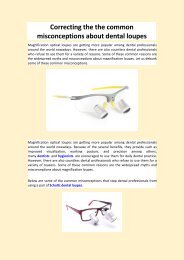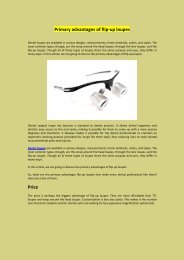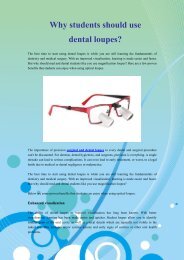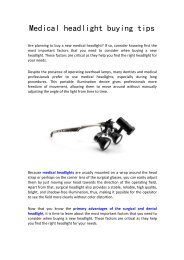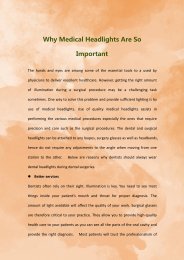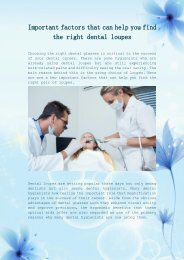The Essence Of Magnification And Surgical Glasses To Surgery
The innovation in surgical loupes technology has offered a lot of benefits not only for the surgeons but also for the patients. Making tiny and complex details, as well as small structures clearer, closer, and more visible is perhaps the key advantage of magnification devices.
The innovation in surgical loupes technology has offered a lot of benefits not only for the surgeons but also for the patients. Making tiny and complex details, as well as small structures clearer, closer, and more visible is perhaps the key advantage of magnification devices.
You also want an ePaper? Increase the reach of your titles
YUMPU automatically turns print PDFs into web optimized ePapers that Google loves.
<strong>The</strong> <strong>Essence</strong> <strong>Of</strong> <strong>Magnification</strong> <strong>And</strong><br />
<strong>Surgical</strong> <strong>Glasses</strong> <strong>To</strong> <strong>Surgery</strong>
<strong>The</strong> continuous advances in technology have revolutionized the field<br />
of surgery and have resulted in more sophisticated and advanced<br />
surgical techniques. Among these technological advancements are<br />
the developments in magnification devices (like the surgical loupes),<br />
intraoperative imaging, suture and implant materials,<br />
miniaturization of instruments, developments in endoscopy, and<br />
stereotactic surgery. Let us take a look at how the development in<br />
magnification devices and the innovation of surgical glasses<br />
revolutionized surgery.<br />
Technological advances have undeniably revolutionized not only the<br />
field of surgery but the medical and dental industry as well. With the<br />
continuous developments in technology, surgical techniques are also<br />
becoming more sophisticated most specifically in the field of<br />
reconstructive and microvascular surgery.
Some of these notable revolutionary technological advancements are<br />
the developments in magnification devices (like the surgical loupes),<br />
intraoperative imaging, suture and implant materials,<br />
miniaturization of instruments, developments in endoscopy, and<br />
stereotactic surgery.<br />
How can magnification be achieved?<br />
One way to achieve magnification is to use either surgical loupes,<br />
microscopes, or endoscopes. <strong>Surgical</strong> optical loupes come in various<br />
magnification ranging from 2.5x to 6.0x. Microscopes, on the other<br />
end, offer magnification that ranges from 6x to 40x.
Each of these magnification devices has its own uses, purposes,<br />
advantages, and disadvantages. <strong>Of</strong> these three precision instruments,<br />
the most widely used and the most convenient is the portable loupes.<br />
<strong>Magnification</strong> and surgical loupes technology<br />
<strong>The</strong> innovation in surgical loupes technology has offered a lot of<br />
benefits not only for the surgeons but also for the patients. Making<br />
tiny and complex details, as well as small structures clearer, closer,<br />
and more visible is perhaps the key advantage of magnification<br />
devices.<br />
Performing surgical operations and procedures is certainly not easy<br />
most especially those specialized and complex procedures in<br />
different surgical disciplines like in otorhinolaryngology,<br />
transplantation surgery, pediatric surgery, hand and plastic surgery,<br />
urology, neurosurgery, vascular surgery, and oncology. Let alone, if<br />
you consider the fact that both the working site and the operating<br />
room are full of various challenges. It can even become more<br />
challenging without the aid of the necessary optical devices like
the surgical glasses and without the right amount and quality of light.<br />
<strong>The</strong> good news is that these surgical operation challenges can be<br />
greatly reduced, if not eliminated, with the help of precision<br />
instruments.<br />
In order to deliver a higher quality treatment and a more precise<br />
diagnosis, it is critical for you to have good vision and a better access<br />
to your working area. Precision instruments, specifically the surgical<br />
magnification loupes, enable you to see the operating area with<br />
greater clarity and in greater detail.<br />
Should you use a surgical headlight?<br />
<strong>The</strong> right amount, quality, and consistency of light are critical for<br />
every surgical operation you will perform. While the traditional<br />
overhead lamp and operating lights can provide you with a good
illumination, the light they produce is not always the same quality,<br />
amount, and consistency that your working site needs. <strong>Surgical</strong><br />
headlights can fill up whatever it is that the traditional overhead<br />
lamp and operating lights can’t provide.<br />
Attaching a headlight to the surgical loupe does not only provide you<br />
with an advanced level of illumination, it likewise helps maximize<br />
your optical magnification device’s full potential. <strong>Surgical</strong> headlights<br />
can further enhance your visual acuity, precision, and accuracy by<br />
providing a high-quality and shadow-free illumination.<br />
Final words<br />
With both the right level of magnification and the quality, quantity,<br />
and consistency of light, you can be able to better appreciate smaller<br />
neurovasculature and precise anatomic details. <strong>Magnification</strong> and<br />
illumination also greatly enhance tissue visualization, precision, and<br />
treatment quality. <strong>The</strong>y can likewise make it easier for you to<br />
position microsurgical instruments as well as to precisely carry out<br />
suture placement.





